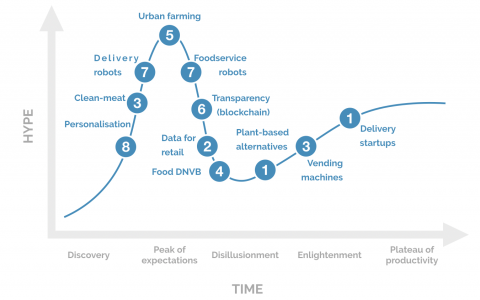It’s one thing to publish “predictions” for the year, it is another one to come back one year later and analyse them with a critical eye. I will try to do that as objectively as possible on the 8 trends that we listed exactly one year ago for the Future of FoodTech. How have these trends evolved on the innovation curve (from discovery to the peak of expectations to productivity) and have we, at DigitalFoodLab, forgotten important elements?

In this graph are listed the 8 trends that DigitalFoodLab listed in January 2019 as the most important for the future of FoodTech and how they evolved on the Gartner’s innovation curve (from an unknown discovery to the thing everyone speaks of to desolation and finally productivity)
What were the trends and how have they evolved?
- Delivery startups: Delivery startups are still the place where investors put the bulk of their money when looking at FoodTech. If we were right in our estimation of delivery startups reaching productivity, vending machines have not been as hot in 2019 as we thought. In 2019, delivery startups have:
- Been less numerous, notably in Europe where consolidation is underway (Takeway’s acquisition of Just Eat and Delivery Hero’s European activities)
- Moved toward profitability
- Seen the rise of cloud Kitchens as a new business model
- Data For retail and Transparency: more and more startups have been targeting retailers and food brands to help them create more transparency
- Plant-based startups: two startups, Beyond Meat and Impossible Foods have at the heart of FoodTech this year with their meat substitutes that are now present in most quick-service restaurants in the USA and soon worldwide. In the meantime, clean meat startups have known their best year ever and are now one or two years away from reaching the market with their lab-grown meat products.
- Digital Native Vertical Brands (DNVB): new food brands created by startups are still popping up every week and have a bright future
- Urban farming: again a great year for urban farms with huge deals such as Infarm’s $100m funding. Now, these startups have to prove that they can be profitable and have their place in the “real world” supply chains.
- Robots in production and delivery: 2019 has been rough for cooking robots with Zume layoffs. As Urban farming startup, they have to show how they work in the real world.
- Personalisation: 2019 has seen new interesting moves in the space of personalisation with new tests and coaching startups and more personalised products.
The big absence: packaging
I would say that it’s not too bad for a set of predictions and we’ve got a pretty good job at looking what people would talk about in 2019 and how things would move on. However, we have forgotten one big trend when doing this mapping: packaging. Creating more eco-friendly packagings and avoiding waste is one of the things we have been asked about the most.
We are now working on our 2020 edition of the FoodTech trends. Stay tuned (and obviously don’t forget to send me your critics on our analysis).







